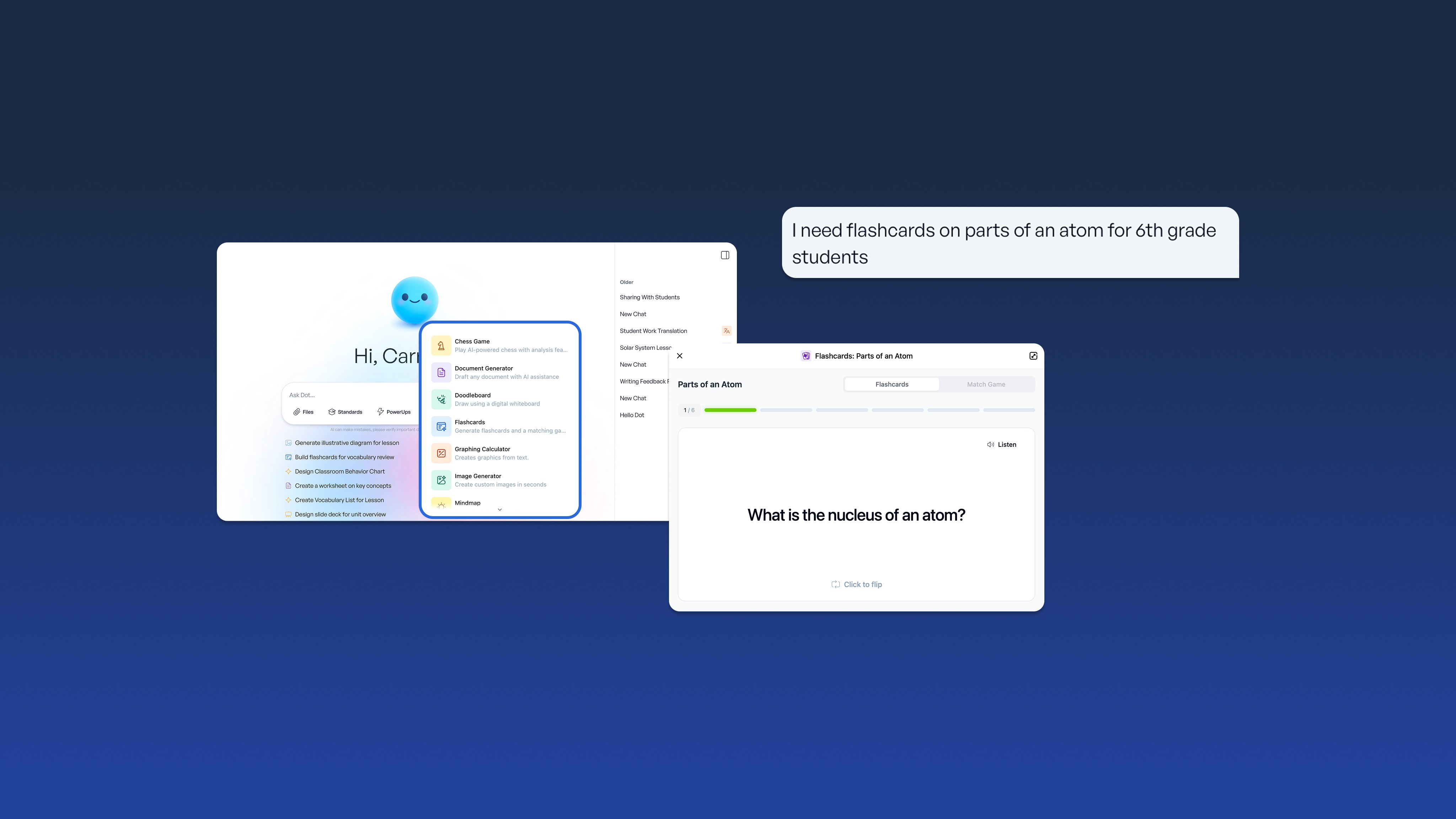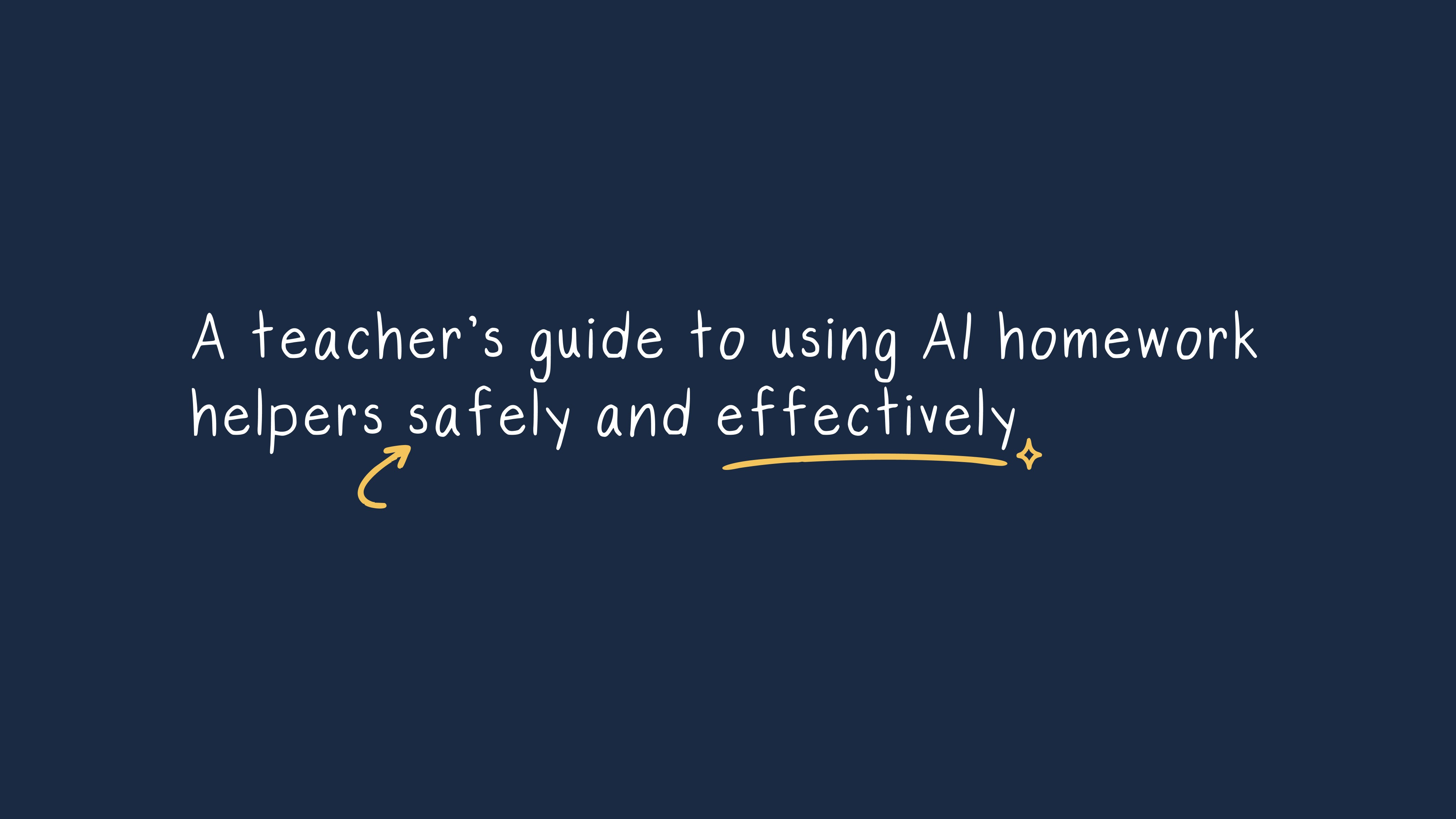Nikki Muncey
Jun 9, 2025
Get started
SchoolAI is free for teachers
Key takeaways
Intelligent tutoring systems create custom learning paths, provide adaptive feedback, and track math progress in real-time, significantly improving achievement especially for younger students.
Some platforms flip traditional approaches by letting students teach an AI peer, guiding it through math problems and fixing its mistakes.
The best AI math resources break complex mathematical concepts into manageable steps with structured problem-solving across all grade levels.
Camera-based solution methods transform learning by allowing students to capture math problems visually to get step-by-step solutions, helping them grasp abstract concepts in concrete ways.
AI math platforms collect rich analytics that help teachers quickly spot struggling students, adjust lesson pacing, and provide targeted help when needed.
AI is breathing new life into traditional methods of teaching and learning math, through tools that adapt to each student's unique needs. AI-powered platforms help teachers customize lessons and use data to enhance their students’ math skills, creating personalized learning journeys that meet students exactly where they are.
From intelligent tutors that walk students through problems step-by-step to platforms that automatically adjust difficulty levels, these AI tools are transforming how students connect with mathematical concepts.
The 10 best AI tools for math proficiency
AI is enhancing math education with smart apps that boost learning experiences and results. Here are the top AI tools for math proficiency representing the most effective solutions available today:
SchoolAI
SchoolAI seeks to transform the everyday learning experience through customized, teacher-first platforms powered by AI. It offers one-on-one AI tutors that guide students through math concepts based on their strengths and interest areas, with real-time dashboards that flag learning gaps and track student progress. Plus, it integrates perfectly with popular classroom tools like Canvas or Google Classroom.
Wolfram Alpha
Wolfram Alpha shines as a computational knowledge engine with structured problem-solving that covers math, physics, and chemistry. Its step-by-step solutions help students grasp the process behind answers—not just the final result. The platform works for all grade levels and math topics, from basic arithmetic to advanced calculus, breaking complex concepts into manageable steps.
Socratic by Google
Socratic by Google acts as an AI-powered educational assistant focused on homework help and building understanding. Its natural language processing interprets questions and provides clear explanations across subjects. This versatility, plus integration with Google Lens and their education tools, makes it valuable for extending support beyond class hours, giving students help when they need it most.
Photomath
Photomath transforms math problem-solving with its camera-based solution method. Students simply snap a picture of a math problem to get step-by-step solutions—making it incredibly user-friendly. The app's visualization features help students grasp abstract concepts in concrete ways, covering everything from basic math to calculus with the step-by-step guidance that research shows improves student outcomes.
Mathway
Mathway offers a comprehensive platform for various math topics from algebra to statistics. Its clean interface and focus on explanations build conceptual understanding, not just answer-finding. Available on web and mobile platforms, Mathway supports learning anywhere at anytime.
Microsoft Math Solver
Microsoft Math Solver combines problem scanning with detailed explanations, making it powerful for tackling diverse math challenges. The solver excels with geometric proofs and complex concepts, using visualization to build understanding through interactive graphing features that help students see functions and relationships clearly.
Maple Calculator
Maple Calculator excels with interactive graphing and math visualization, particularly useful for understanding calculus, algebra, and advanced topics. Teachers can use this tool for classroom demonstrations that bring abstract concepts to life. Its advanced computational features support higher-level mathematics in both high school and college settings.
MyScript Calculator
MyScript Calculator brings a fresh approach with handwriting recognition that enhances note-taking and problem-solving by connecting handwritten math to digital solutions. This tool especially helps students who prefer working problems by hand but need digital assistance. Its intuitive interface works well for various learning approaches.
Symbolab
Symbolab offers advanced problem-solving capabilities and extensive calculator options that integrate with educational curricula for comprehensive learning. Its step-by-step approach helps students grasp underlying concepts rather than memorize procedures. Teachers can use Symbolab for curriculum planning and showing multiple solution methods.
Math Solver by Cymath
Math Solver by Cymath offers real-time tutoring insights and personalized learning paths. It adapts to student progress, providing support that evolves with the learner.
The evolution of AI in math education
The journey of artificial intelligence in mathematics education has been remarkable, moving from simple calculators to sophisticated learning platforms that tailor the educational experience to each student.
This shift represents a move away from one-size-fits-all teaching toward personalized environments that promote math mastery.
Intelligent Tutoring Systems (ITS) mark one of the biggest breakthroughs in this field. These systems create custom learning experiences, provide adaptive feedback, and track progress in real-time. Research published in the International Electronic Journal of Mathematics Education confirms these systems can significantly improve math achievement, especially for younger students.
Alongside these tutors, Adaptive Learning Systems have grown increasingly sophisticated. They adjust difficulty based on student performance, use predictive analytics to spot learning gaps, and break complex concepts into bite-sized pieces.
AI problem solvers and generative tools have also transformed instruction. Platforms like ChatGPT and custom GPTs now generate diverse math problems, offer explanations at different levels, and support collaborative problem-solving.
An innovative approach comes from teachable AI agents like ALTER-Math. This platform flips the script by letting students teach an AI peer, guiding it through problems and fixing its mistakes. When tested with 6,000 students, those using ALTER-Math showed learning gains 1.56 times higher than control groups.
In addition, the incorporation of AI tools into mathematics education represents a unique opportunity to teach students how to use these tools responsibly. So far, many students have relied on these tools as a way to “get out of” doing their math assignments themselves. Now, teachers can demonstrate how students can use AI to master concepts and solve problems collaboratively while continuing to apply themselves to the subject.
Criteria for selecting AI tools for math proficiency
When choosing AI tools for math education, educators should consider several key factors to ensure effective classroom integration and optimal learning outcomes:
Alignment with curriculum and pedagogy
AI tools must seamlessly integrate with existing curriculum standards. The National Council of Teachers of Mathematics (NCTM) emphasizes that AI tools should complement, not replace, fundamental math teaching and problem-solving skills. Look for tools that support your specific curriculum standards and enhance your teaching philosophy.
Mathematical accuracy and rigor
The quality and accuracy of content delivered through AI tools is paramount. Evaluate the mathematical rigor of AI-generated content and how well the tool prevents mathematical misconceptions.
Personalization and adaptive learning capabilities
One of the most significant advantages of AI is its ability to personalize learning. Adaptive learning platforms analyze student progress and dynamically modify lessons, ensuring each student receives targeted instruction at the appropriate level of challenge. Look for tools offering individualized learning paths, real-time feedback, and customized problem generation.
Assessment and progress monitoring
Effective AI tools should provide robust assessment capabilities to track progress and inform instructional decisions. Consider tools that offer comprehensive analytics, actionable insights that translate into teaching strategies, and real-time data on student understanding.
Engagement and interactivity
Student engagement is crucial for effective learning. AI tools can significantly impact this through gamification elements, interactive features like virtual math tutors, and age-appropriate design.
Accessibility and cost-effectiveness
Ensure the AI tool is compatible with your school's existing technology infrastructure and accessible to all students. Consider device compatibility, accessibility features for students with disabilities, and various pricing models.
Data privacy and security
Ensure that the AI tool complies with privacy laws and protects student data, especially important when dealing with personalized learning platforms that collect and analyze student information.
By systematically evaluating AI tools against these criteria, educators can make informed decisions that optimize student learning in mathematics education. The goal is to enhance, not replace, effective teaching practices.
How to implement AI math tools in your classroom
Bringing AI tools into math teaching requires a thoughtful approach to maximize benefits and overcome challenges. Here's a practical framework:
Identify needs and research tools
Start by pinpointing your teaching priorities. Do you need better differentiated instruction, simpler assessment, or more engaged students? Once clear on your goals, find AI tools that match these needs. Judge options by design quality, analytics, privacy protections, and access for all students.
Plan a phased rollout
Start small and build gradually. Try a pilot program in select classrooms first. This helps prove value and build support before full implementation. Create timelines for student orientation, teacher training, and technical support to ensure smooth transitions.
Invest in professional development
Thorough, ongoing training makes or breaks successful AI integration. Run hands-on workshops, set up peer mentoring, and provide continuous support to build AI skills among your staff. Focus on practical applications that fit your specific tools and curriculum.
Create blended learning environments
AI should enhance traditional teaching, not replace it. Design lessons mixing AI-powered personalization with teacher-led activities. For example, use adaptive platforms for individual practice, freeing class time for group problem-solving and deeper discussions.
Leverage data analytics
Most AI math tools provide rich analytics. Train teachers to interpret this data to guide their teaching. Real-time insights help quickly spot struggling students, adjust lesson pacing, and provide targeted help when needed.
Address equity and accessibility
Make sure all students can access the technology needed for AI learning. This might mean upgrading school equipment, providing take-home devices, or partnering with community groups to improve internet access for underserved students.
Develop clear policies around AI tools
Create guidelines for AI tool usage, data privacy, and classroom management. Clear policies maintain consistency across classrooms and address potential concerns from parents and administrators.
Continuously evaluate and refine
Regularly check how AI tools affect student learning, engagement, and teacher workload. Gather feedback from everyone involved and be ready to adjust your approach as needed.
Making math fun again with AI
The top AI tools for math enhance learning through personalization at scale, differentiated instruction, and real-time support. Platforms like the ones we’ve discussed here help students achieve significant improvements in math proficiency.
For successful implementation, educators must choose tools based on effectiveness evidence, curriculum alignment, and practical considerations while ensuring proper training and support. This, ultimately, will make mathematics more engaging and effective for all students regardless of background or starting point.
Ready to transform your math classroom with AI? SchoolAI offers customized solutions that can help your students achieve math mastery while saving you valuable planning time. Start your journey toward smarter, more personalized math instruction now!
Transform your teaching with AI-powered tools for personalized learning
Always free for teachers.
Recent posts
REFRESH: AI adoption challenges in schools: How to prepare staff and infrastructure
Jennifer Grimes
—
Dec 19, 2025
REFRESH: AI integration: Adding AI tools into your school’s existing technology
Stephanie Howell
—
Dec 19, 2025
Create lesson plans that work: Strategic planning for teachers
Cheska Robinson
—
Dec 18, 2025
A teacher’s guide to using AI homework helpers safely and effectively
Heidi Morton
—
Dec 18, 2025





